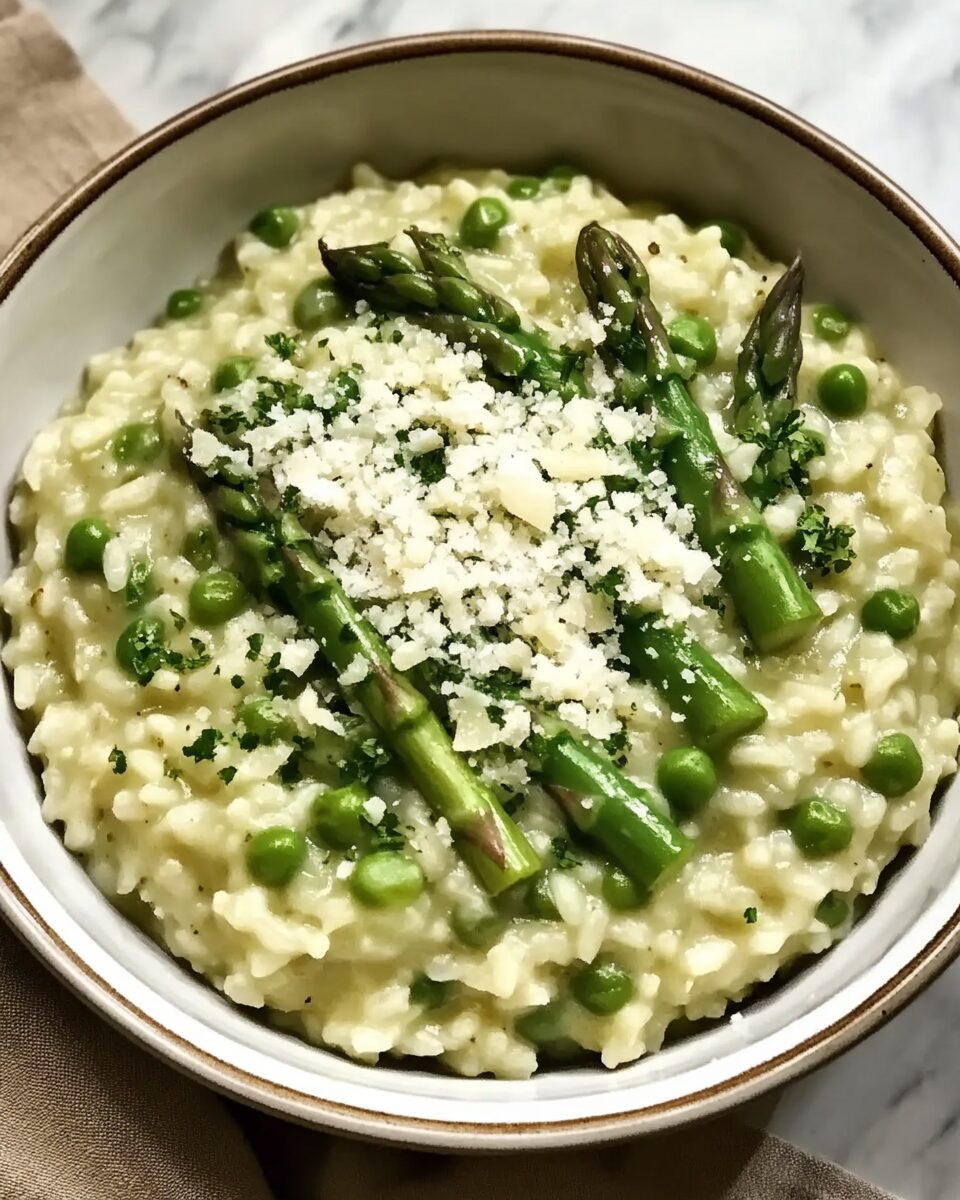A Celebration of Seasonal Ingredients
One of the most beautiful aspects of this risotto is how it showcases fresh, seasonal produce. Asparagus, a spring favorite, brings a tender snap and grassy notes that contrast perfectly with the creaminess of the rice. Sweet green peas add a pop of natural sugar and color, complementing the asparagus while adding their own unique texture. These ingredients don’t just taste good—they also bring vibrant green hues to the plate, creating a dish that’s visually as fresh and lively as it tastes. For anyone who enjoys cooking with the rhythm of the seasons, this risotto is a perfect way to celebrate spring’s bounty.
The Creaminess of Traditional Risotto, Without the Heaviness
Risotto has a reputation for being rich and decadent, but this version maintains that beloved creaminess without feeling heavy or overly indulgent. Thanks to the starch released from Arborio rice during the slow cooking process, the dish develops a naturally creamy consistency without relying on loads of butter or cream. A touch of olive oil and a modest amount of Parmesan cheese (or nutritional yeast for a vegan twist) are all it needs to come together. The result is a risotto that feels indulgent yet remains light enough to enjoy on a sunny spring day, whether you’re dining indoors or al fresco.
Arborio Rice – The Heart of a Great Risotto
At the core of every risotto is the rice, and Arborio is the undisputed star for good reason. This short-grain Italian rice is prized for its high starch content, which gives risotto its signature silky texture. As it slowly absorbs broth during the cooking process, it releases starch that naturally thickens the dish, making it luxuriously creamy without added fat. Arborio rice also holds its shape well, staying firm at the center while becoming tender on the outside. This perfect texture contrast makes each spoonful deeply satisfying. If you’re new to risotto, this recipe is an ideal introduction—it’s forgiving, rewarding, and impressive with minimal effort.
Wine and Broth – Building Flavor from the Base Up
A splash of white wine at the beginning of the cooking process adds a gentle acidity that enhances the other flavors in the dish. While optional, it provides a subtle depth and aroma that elevates the overall profile of the risotto. After the wine has absorbed, warm vegetable broth is added gradually, one ladle at a time, encouraging the rice to release its starches while absorbing flavor. This method requires some attention, but the results are well worth it. The continual stirring and slow broth incorporation create the smooth, creamy consistency that defines a great risotto.
A Dish That’s Both Comforting and Elegant
Asparagus and Pea Risotto is comfort food with a refined edge. It’s simple enough to make for a quiet weeknight dinner but elegant enough to serve at a special gathering or intimate dinner party. The gentle green tones and the delicate balance of flavors give it a sophisticated appeal, while its satisfying creaminess keeps it grounded and approachable. Pair it with a glass of chilled white wine and a side of crusty bread or a crisp green salad for a meal that feels restaurant-worthy, yet is made effortlessly at home.
Nourishing and Wholesome Without Compromise
This risotto isn’t just delicious—it’s nourishing, too. Peas are a great source of plant-based protein, fiber, and essential vitamins like C and K. Asparagus adds folate, antioxidants, and a dose of prebiotics that support gut health. Arborio rice provides complex carbohydrates for sustained energy, and the olive oil and Parmesan bring healthy fats and calcium. The result is a dish that feels like a treat but also supports wellness—a balance that’s perfect for those looking to eat well without sacrificing flavor or texture.
Easily Adaptable for Different Diets and Preferences
One of the most versatile things about this risotto is how easily it can be adapted to suit different dietary needs. For a vegan version, substitute the Parmesan with nutritional yeast and use plant-based broth and oil. Want to make it gluten-free? It already is—no changes needed. For added protein, stir in cooked white beans or top with grilled chicken or seared shrimp. You can also experiment with different vegetables depending on the season—zucchini, mushrooms, leeks, or spinach are all great additions that bring their own unique flair to the dish.
Make-Ahead Friendly and Reheats Like a Dream
While risotto is best served fresh, leftovers can be just as enjoyable. Stored in an airtight container in the refrigerator, it keeps well for up to two days. Reheat gently on the stovetop with a splash of broth or water to loosen the texture. You can also reshape it into small patties, coat with breadcrumbs, and pan-fry them into crispy risotto cakes—a brilliant way to reinvent leftovers into something totally new. For meal prep enthusiasts, cooking the risotto base in advance and adding the vegetables right before serving keeps the dish tasting fresh while saving time.
Tips for the Perfect Risotto Every Time
To get the best results, be patient with the broth addition—resist the urge to pour it all in at once. Stirring regularly helps the rice release its starch and prevents sticking. Keep your broth warm to maintain even cooking and avoid shocking the rice with cold liquid. Taste frequently toward the end of cooking to ensure the rice is al dente—soft but with a slight bite in the center. And always finish with a generous sprinkle of Parmesan or nutritional yeast and a touch of fresh parsley for brightness and color.
Conclusion
Asparagus and Pea Risotto is a vibrant, elegant dish that celebrates the best of spring’s produce while delivering the rich, comforting texture of classic risotto. With its creamy base, fresh vegetables, and fragrant Parmesan finish, it’s a dish that feels both hearty and light, indulgent yet wholesome. Whether you’re cooking for family, impressing friends, or simply treating yourself to a quiet night in, this risotto is a versatile, satisfying recipe that never disappoints. Beautiful on the plate and bursting with flavor, it’s sure to become a seasonal favorite that you’ll return to again and again.






